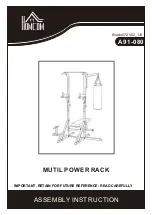
14
Version 1.0 - 2012
Manual XrGi 20G-To
Main known sources of incomplete combustion are the following:
This list does not claim to be exhaustive.
One commonly found factor in practice are the solvents used in cleaners, adhesives and paints. Chemical cleaners and
degreasing baths can give off halogen compounds, as may floor adhesives and others. Construction varnishes, paints and
adhesives made in Germany have been made without halogenated hydrocarbons for some years now. Free halogen com-
pounds arise mainly if CFC-based paint strippers or adhesive removers are used, and when boiler rooms are painted anew.
The bleaching lye or hydrochloric acid often used for disinfection and cleaning purposes can also cause corrosion.
Professional craftspeople have more or less ceased using HCFC-based spray paints and adhesives.
If you cannot eliminate halogenated hydrocarbon sources, such as in a hairdressing salon, swimming pool, dry cleaners, etc.
you must ensure the combustion air supply is taken only from unpolluted areas.
Industrial sources
Chemical cleaners
Degreasing baths
Printing works
Cooling equipment
Domestic sources
Cleaners and degreasing
agents
Hobby areas
Solvents and thinners
Spray cans
Trichloroethylene, a hydrofluorocarbon
Perchlorethylene, trichloroethylene, methylene chloride
Trichloroethylene
Methyl chloride, trichlorofluoromethane, dichlordifluoromethane
Perchlorethylene, methyl chloroform, trichloroethylene, methylene chloride, car-
bon tetrachloride, hydrochloric acid
Chlorinated hydrocarbons
Hydrofluorocarbons (Frigen)
1.2.8. Filling and top-up water
The heated water must be used for heating purposes in closed circuits only and must not be bled off to be used.
Engine circuit water is filled and topped up from the heating circuit via the shutoff valve in the Q60-Heat Distributor. Check that
the heating water meets VDI 2035 requirements.
Knowing the water hardness according to the detergents law is not sufficient: you need to ask your water supply company
what its carbonate and/or calcium hardness is.
Stating carbonate hardness is normally sufficient. If you know both the carbonate and calcium hardness, use whichever value
is lower to give the permitted water flow in Tables 1-3 in [°dH].
We advise you comply with the following safety precautions:
Minimise top-up water requirements by fitting shutoff valves that can be closed during repairs and regular checks of the
expansion vessel.
Adding chemicals to stabilise hardness is not advised, as lime may be precipitated as sludge.
Softening and deionisation by cation exchange, ion exchange or reverse osmosis are the most reliable methods to prevent
scale formation.
Table 1-1: Converting carbonate hardness (K
S4,3
): [°dH] = 2.79 * [mol/m³]
Table 1-2: Converting calcium hardness (Ca²
+
): [°dH] = 5.59 * [mol/m³]
[ºdH]
1 2 4 6 8 10 12 14 16 18 20 22 24
[mol/m³]
0.4 0.7 1.4 2.1 2.8 3.6 4.3 4.9 5.6 6.4 7.2 7.9 8.6
[ºdH]
1 2 4 6 8 10 12 14 16 18 20 22 24
[mol/m³]
0.2 0.4 0.7 1.1 1.4 1.8 2.2 2.5 2.8 3.2 3.6 4.0 4.3
Summary of Contents for XRGI 20G-TO
Page 1: ...System components Installation INSTRUCTIONS...
Page 2: ...2 Version 1 0 2012 Manual XRGI 20G TO...
Page 98: ...98 Version 1 0 2012 Manual XRGI 20G TO...
Page 131: ...131 Version 1 0 2012 Manual XRGI 20G TO...
Page 152: ...152 Version 1 0 2012 Manual XRGI 20G TO...
Page 153: ...153 Version 1 0 2012 Manual XRGI 20G TO...
Page 154: ...154 Version 1 0 2012 Manual XRGI 20G TO...
Page 155: ...155 Version 1 0 2012 Manual XRGI 20G TO...
Page 156: ...156 Version 1 0 2012 Manual XRGI 20G TO...
Page 157: ...157 Version 1 0 2012 Manual XRGI 20G TO...
Page 158: ...158 Version 1 0 2012 Manual XRGI 20G TO...
Page 159: ...159 Version 1 0 2012 Manual XRGI 20G TO...
Page 160: ...160 Version 1 0 2012 Manual XRGI 20G TO...
Page 161: ...161 Version 1 0 2012 Manual XRGI 20G TO...
Page 162: ...162 Version 1 0 2012 Manual XRGI 20G TO...
Page 166: ...166 Version 1 0 2012 Manual XRGI 20G TO Notes...
Page 167: ...167 Version 1 0 2012 Manual XRGI 20G TO...
Page 168: ......















































